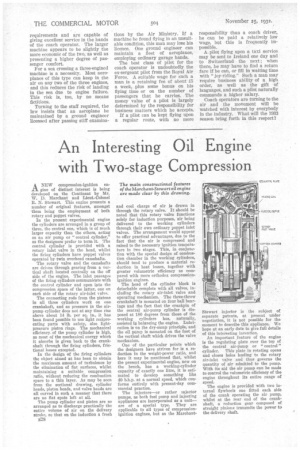An Interesting Oil Engine with Two-stage Compression
Page 46

If you've noticed an error in this article please click here to report it so we can fix it.
ANEW compression-ignition engine of distinct interest is being developed on the Continent by Mr. W. D. Merchant and Lieut.-Colonel R. N. Stewart. This engine presents a number of original features, amongst -them being the employment of both rotary and poppet valves.
In the present experimental engine the cylinders are arranged in a group of three, the central one, which is of much larger capacity than the others, acting as an air pump or "control cylinder," as the designers prefer to term it. The control cylinder is provided with a rotary inlet valve in the head, whilst the firing cylinders have poppet valves operated by twin overhead camshafts.
The rotary valve and the camshafts are driven through gearing from a vertical shaft located centrally on the off side of the engine. The inlet passages of the firing cylinders communicate with the control cylinder and open into the compression space of the latter, one on each side of the rotary air-inlet valve.
The connecting rods from the pistons in all three cylinders work on one crankshaft, and as pressure in the airpump cylinder does not at any time rise above about 14 lb. per sq. in., it has been found possible to use light reciprocating parts with safety, also lightpressure piston rings. The mechanical efficiency_ of the pump cylinder is high, as most of the mechanical energy which it absorbs is given back to the crankshaft through the firing cylinders, frictional losses excepted.
In the design of the firing cylinders the object aimed at has been to obtain the maximum amount of turbulence by the elimination of flat surfaces, whilst maintaining a suitable compression ratio, without reducing the combustion space to a thin layer. As may be seen from the sectional drawing, cylinder heads, piston heads, and valve heads are all curved in such a manner that there are no flat spots left at all.
The pump cylinder and piston are so arranged as to discharge practically the entire volume of air on the delivery stroke, so that on the induction a fresh
and cool charge of air is drawn in through the rotary valve. It should be noted that this rotary valve functions solely for induction purposes, air being delivered to the working cylinders through their own ordinary poppet inlet valves. The arrangement would appear to offer practical advantages, due to the fact that the air is compressed and raised to the necessary ignition temperature in two stages. This, in conjunction with the special design of combustion chamber in the working cylinders, should tend to produce a material reduction in heat losses, together with greater volumetric efficiency as compared with more orthodox compressionignition engines.
The head of the cylinder block is detachable complete with all valves, including the rotary air-inlet valve and operating mechanism. The three-throw crankshaft is mounted on four ball bearings and the fact that the crankpin of the central air-pump cylinder is disposed at 180 degrees from those of the working cylinders has, naturally, assisted in balancing the engine. Lubrication is on the dry-sump principle, and the oil pump is mounted on the foot of the vertical shaft which drives the valve mechanism.
One of the particular points whieli the designers have striven for is a reduction in the weight-power ratio, and here it may be mentioned that, whilst the present experimental engine, now on the bench, has a working-cylinder capacity of exactly one litre, it is estimated to develop something like 40 b.h.p. at a normal speed, which conforms entirely with present-day commercial practice.
The injectors—or rather injector pumps, as both fuel pump and injecting appliances are incorporated as a unit— are of a special type. They are applicable to all types of compressionignition engines, but as the Merchant
Stewart injector is the subject of separate patents, at present under negotiation, it is not possible for the moment to describe this appliance. We hope at an early date to give full details of this interesting invention.
An important feature of the engine is the regulating plate over the top of the central air-pump or " control " cylinder. This plate in rotating opens and closes holes leading to the rotary air-inlet valve and thus governs the quantity of air admitted to the pump. With its aid the air pump can be made to control the volumetric efficiency of the engine throughout its entire range of speed.
The engine is provided with two internal flywheels one fitted each side of the crank operating the air pump, whilst at the rear end of the crankshaft, a reduction gear composed of straight pillions transmits the power to the delivery shaft.




































































































